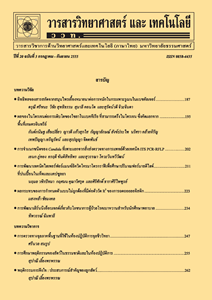การวิเคราะห์ปริมาณเกลือโซเดียมคลอไรด์ในผลิตภัณฑ์น้ำปลาไทย
Main Article Content
Abstract
A fish sauce is made from a fermentation of fish and salt. It is a clear reddish-golden brown color and salted taste. Sodium chloride plays an important role in taste and quality of the fish sauce that is essential for a qualified exporting product in Thailand. The concentration of sodium chloride must be controlled strictly under national and international quality standards. This work focused on determination of sodium chloride in samples of Thai fish sauce using Mohr’s titration method, and comparison the quantified results to the international food standards code and standard of the Ministry of Industry. Thai commercial fish sauce products, which were pure fish sauce of 35 samples and mixed fish sauce of 21 samples, were purchased from local stores and supermarkets in Pathum Thani and Bangkok, Thailand. The measurable quantity obtained from those samples, was compared to the international (CODEX STAN 302-2011) and national (Thai industrial standard institute, TIST) standards.
Article Details
References
[2] Notification of the Ministry of Public Health, 1989, Fish Sauce, Department of Health, Bangkok. (in Thai)
[3] Park, J.N., Fukumoto, Y., Fujita, E., Tanaka, T., Washio, T., Otsuka, S., Shimizu, T., Watanabe, K. and Abe, H., 2001, Chemical composition of fish sauces produced in southeast and east Asian countries, J. Food. Compos. Anal. 14: 113-125.
[4] Bunchoo, B. and Sampanthararak, Y., 2012, Department of Science Service join to push the Thai fish sauce testing method to Codex standards, Booklet of Department of Science Service 190: 6-8. (in Thai)
[5] Placido, A., Kupers, R., Paiga, P., Magalhaes, J., Nouws, H.P.A., Celerue-Matos, C. and Oliveria, M.B.P.P., 2012, Salt content in bread and dough from Northern Portugal: Method development and comparison, J. Food. Compos. Anal. 27: 14-20.
[6] Food Intelligence Center Thailand, National Food Institute, Ministry of Industry Thailand, Sauce and Condiment in Thailand, Available Source: https://fic.nfi.or.th/MarketOverviewDomesticDetail.php?id=82, May 8, 2019. (in Thai)
[7] Ministry of Commerce, Major Export Market Fish Sauce, Available Source: https://www.ops3.moc.go.th/infor/menucomth/stru1_export/export_market/report.asp, June 27 2018. (in Thai)
[8] Codex Alimentarius-International Food Standard, Codex Stan 302-2011 Standard for Fish Sauce, Available source: www.codexalimentarius.org, December 1, 2017.
[9] Thai Industrial Standard, 1983, Local Fish Sauce Standard, Department of Industry, Bangkok. (in Thai)
[10] Pornchaloempong, P., Rattanapanon N., Salt Curing, Available Source: https://www,foodnetworksolution.com/wiki/word/1322/salt-curing, May 22 2017. (in Thai)
[11] Huynh, H.L., Danhi, R. and Yan, S.W., 2016, Using fish sauce as a substitute for sodium chloride in culinary sauces and effects on sensory properties, J. Food. Sci. 81: S150-S155.
[12] Notification of the Ministry of Public Health, 1998, Nutrition Facts, Department of Health, Bangkok. (in Thail)
[13] Ritthiruangdej, P., Suwonsichon, T., Oazki, Y., Haruthaithanasan, V. and Thanapase, W., 2006, Classification of Thai commercial fish sauces by near-infrared spectroscopy with chemomtrices, Kasetsart J. (Nat. Sci.) 40: 189-196. (in Thai)
[14] Sangjindavong, M., Chuapoehuk, P. and Vareevanich, D., 2005, Studies on Nham-Pla’s processing by using rock salt and solar salt, Kasetsart J. (Nat. Sci.) 39: 294-299. (in Thai)
[15] Chen, M.J., Hsieh, Y.T., Weng, Y.M. and Chiou, R.Y.Y., 2005, Flame photometric determination of salinity in processed foods, Food Chem. 91: 765-770.
[16] Galvis-Sanchez, A.C., Toth, I.V., Portela, A., Delgadillo, I. and Rangel, A.O.S.S., 2011, Monitoring sodium chloride during cod fish desalting process by flow injection spectrometry and infrared spectroscopy, Food Control 22: 277-282.
[17] Johnson, M.E. and Olson, N.F., 1985, A comparison of available methods for determining salt levels in cheese, J. Dairy Sci. 68: 1020-1024.
[18] Zhang, Y. and Xia, W., 2008, A novel method for the determination of sodium chloride in salted fish, Int. J. Food Sci. Tech. 43: 927-932.
[19] SIGMA-ALDRICH, Material Safety Data Sheet (MSDS), Available Source: https://www.chemtrack.org/MSDSSG/Trf/msdst/msdst7761-88-8.html, June 27, 2018


